In modern farming, bird nets are key tools. They’re widely used to protect fruit trees and crops from birds. But, we need to think about their impact on bees, which are crucial for pollinating fruit trees. This article explores whether bird nets affect bees’ activities and how to use them right.
Does Bird Netting Stop Bees from Pollinating?
Bees, given their size and flying skills, usually move through most professional bird nets with ease. So, standard bird nets don’t usually stop bees from pollinating. But, smaller mesh nets, not made for birds, can block bees. This could harm their movement between flowers and lower pollination success.
1. In-Depth Explanation
Farmers use bird nets to keep birds away from fruit trees and crops. These nets, spread over trees or crops, stop birds from getting close.
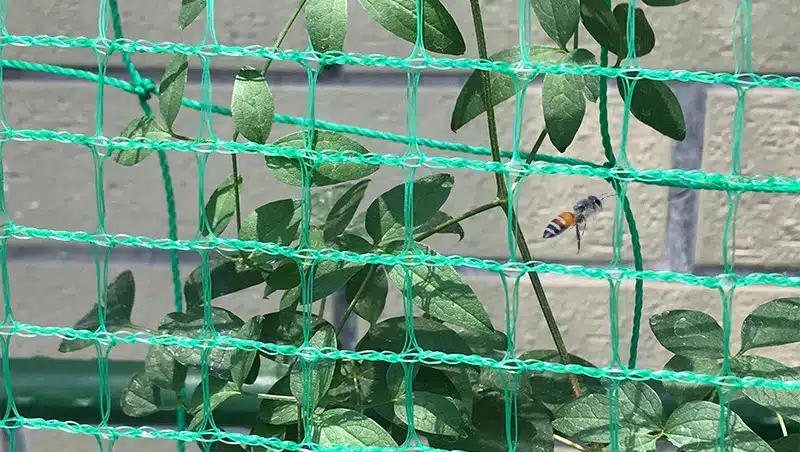
Bee get through bird netting
Professional bird nets have mesh sizes of about 0.59 to 0.98 inches (1.5 to 2.5 centimeters). This size blocks birds but lets helpful insects, like bees, through. Bees are about 0.20 to 0.51 inches (0.5 to 1.3 centimeters) wide, so they pass through easily. This mesh size ensures bees can pollinate without trouble.
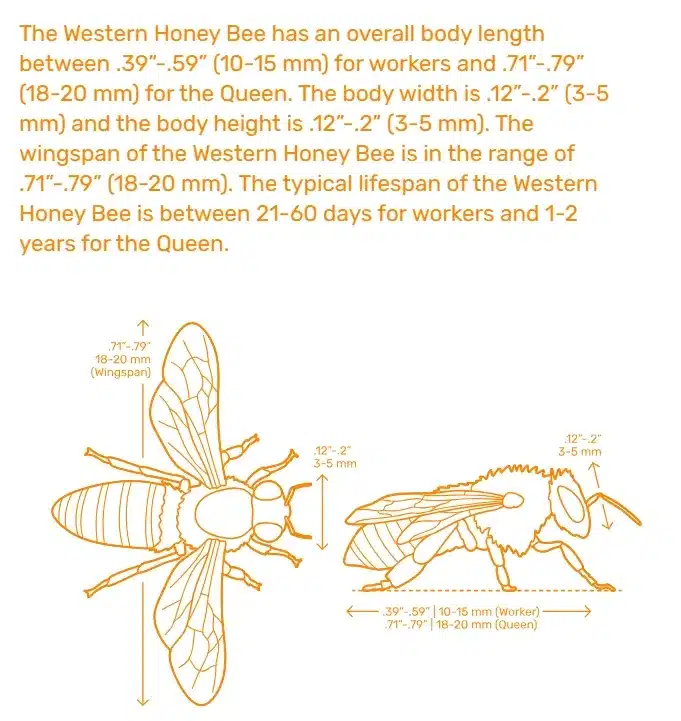
Apis mellifera size
However, some farmers use non-professional alternatives, like insect nets or shade nets, which have smaller meshes. Insect nets, for instance, have meshes around 0.31 to 0.63 inches (0.8 to 1.6 centimeters), aimed at stopping insects from harming crops. These smaller meshes can make it hard for bees to get through. Agricultural shade nets vary in mesh size. They’re used to cut down sunlight on crops, but almost all of them can limit bee movement.
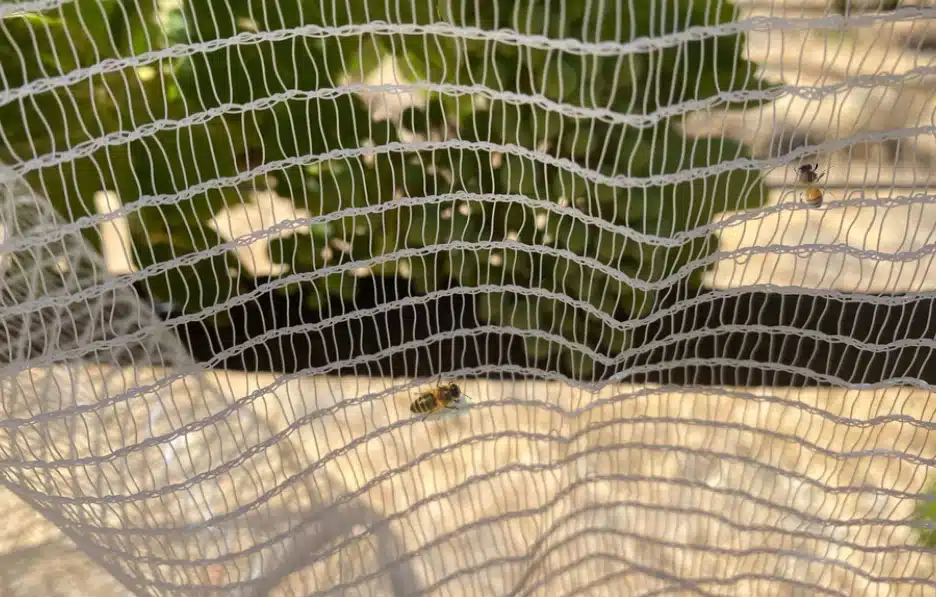
Agricultural Bee Netting
2. Bee Species and Their Sizes
It’s key to know that bees might not always fly through bird nets; sometimes, they crawl. A bee’s ability to get through a bird net largely depends on its width.
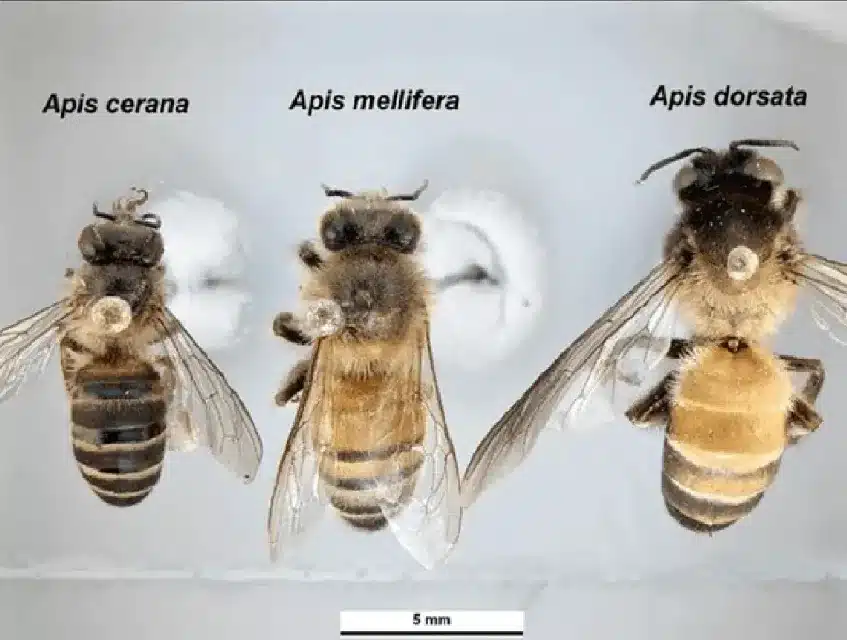
Classification and Sizes of Honeybees
Here’s a table showing major honeybee species and their sizes:
| Bee Species | Length (Approx.) | Width (Estimate) | Regional Distribution |
| Western Honeybee (Apis mellifera) | 1.2 to 1.5 cm (0.47 to 0.59 inches) | ~0.6 to 0.8 cm (~0.24 to 0.31 inches) | Worldwide, originally Europe, Africa, Western Asia; introduced to Americas. |
| Eastern Honeybee (Apis cerana) | 1.0 to 1.3 cm (0.39 to 0.51 inches) | ~0.5 to 0.7 cm (~0.20 to 0.28 inches) | Asia, especially Southeast and South Asia. |
| Giant Honeybee (Apis dorsata) | 2.0 to 2.5 cm (0.79 to 0.98 inches) | ~1.0 to 1.3 cm (~0.39 to 0.51 inches) | South Asia, e.g., India, Nepal, Malaysia. |
| Dwarf Honeybee (Apis florea) | 0.7 to 1.0 cm (0.28 to 0.39 inches) | ~0.4 to 0.5 cm (~0.16 to 0.20 inches) | Tropical, subtropical Middle East, Asia. |
| Himalayan Honeybee (Apis laboriosa) | Over 2.0 cm (Over 0.79 inches) | ~1.0 to 1.4 cm (~0.39 to 0.55 inches) | Himalayas, e.g., Nepal, Bhutan. |
| Iberian Honeybee (Apis mellifera iberiensis) | 1.2 to 1.5 cm (0.47 to 0.59 inches) | ~0.6 to 0.8 cm (~0.24 to 0.31 inches) | Iberian Peninsula (Spain, Portugal). |
| Italian Honeybee (Apis mellifera ligustica) | 1.2 to 1.5 cm (0.47 to 0.59 inches) | ~0.6 to 0.8 cm (~0.24 to 0.31 inches) | Italy and other introduced areas. |
3. Choosing and Using Bird Nets
To let bees pass, pick bird nets with the right mesh size, based on local bee sizes. Avoid small-mesh nets during flowering.
Choosing the right mesh size is crucial. Ideal bird nets have large enough meshes to stop birds and let bees through. Professional bird nets with mesh sizes of 2.0 to 2.5 cm (about 0.79 to 0.98 inches) are usually best. They block most birds and don’t hinder bees.
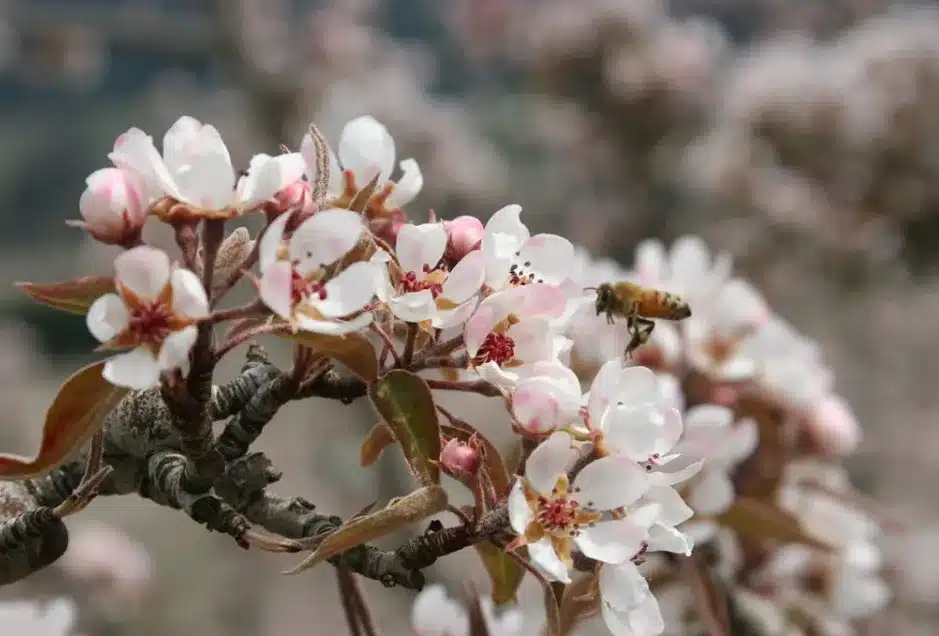
Bees Gathering Nectar from Blooming Fruit Trees
Using bird nets at the right time is also key. During fruit trees’ flowering, bees’ pollination is vital. So, it’s usually best not to use bird nets then. After flowering, when fruits grow and ripen, using bird nets is more suitable. This approach reduces the impact on bee pollination while protecting fruits from birds.
FAQs
FAQ1: What Size Mesh Can Bees Get Through?
Bees usually pass through meshes of 0.59 to 0.98 inches (1.5 to 2.5 centimeters). This size is standard for professional bird nets, effectively blocking birds and allowing bees. Most bees are about 0.20 to 0.51 inches (0.5 to 1.3 centimeters) wide, making this mesh size suitable for them.
FAQ2: Can Bees See Bird Netting?
Bees see differently than humans. They detect ultraviolet light and are sensitive to blue and purple but not red. This means they can somewhat see bird nets. They also use airflow changes and touch when flying near a net. Sensitivity to motion and space changes helps them avoid nets. So, even if bees can’t always clearly see bird nets, they use their senses to navigate safely.
FAQ3: Bees’ Role in Plant Growth
Bees, as top pollinators, play a crucial role in keeping ecological diversity and helping agriculture. By visiting flowers for nectar and pollen, they not only survive but also aid plant pollination and reproduction. In fruit tree cultivation, bees’ pollination directly affects fruit yield and quality.
FAQ4: Other Bird Deterrents and Bees
Besides bird nets, common deterrents include sonic devices and firecrackers. These usually have little direct impact on bees, but long-term, large-scale use might disturb their habits. So, when choosing bird deterrent methods, consider their potential impacts on bees and other pollinating insects.
Conclusion
In short, bees can generally get through professional bird net meshes without significant impact on their pollination activities. Choosing the right bird net type and using it at the right time is crucial for protecting crops and maintaining ecological balance. By considering mesh size and usage time, we can balance agricultural needs with ecosystem health.